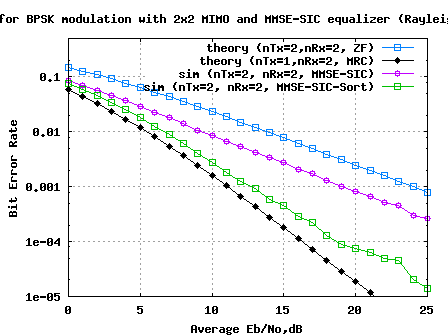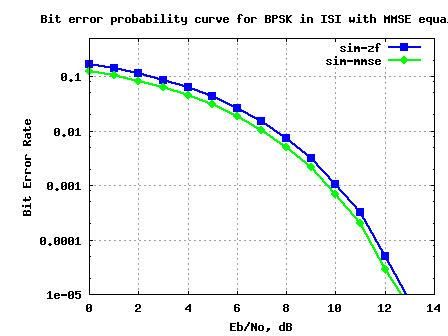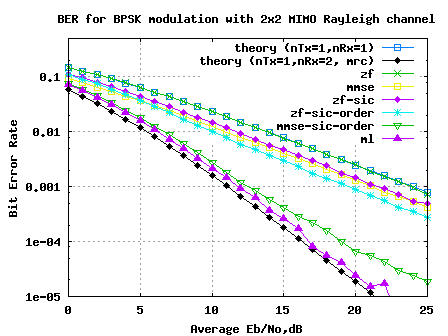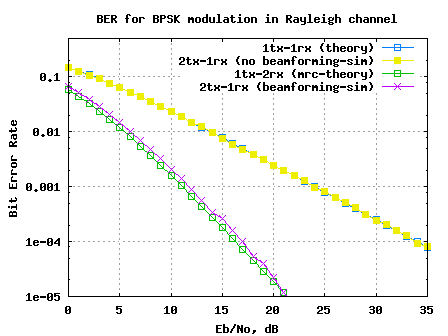This post attempts to build further on the MIMO equalization schemes which we have discussed –
(a) Minimum Mean Square Error (MMSE) equalization,
(b) Zero Forcing equalization with Successive Interference Cancellation (ZF-SIC) and
(c) ZF-SIC with optimal ordering.
We have learned that successive interference cancellation with optimal ordering improves the performance with Zero Forcing equalization. In this post, we extend the concept of successive interference cancellation to the MMSE equalization and simulate the performance. We will assume that the channel is a flat fading Rayleigh multipath channel and the modulation is BPSK.
Brief description of 2×2 MIMO transmission, assumptions on channel model and the noise are detailed in the post on Minimum Mean Square Error (MMSE) equalization.
MMSE equalizer for 2×2 MIMO channel
Let us now try to understand the math for extracting the two symbols which interfered with each other. In the first time slot, the received signal on the first receive antenna is,
.
The received signal on the second receive antenna is,
.
where
,
are the received symbol on the first and second antenna respectively,
is the channel from
transmit antenna to
receive antenna,
is the channel from
transmit antenna to
receive antenna,
is the channel from
transmit antenna to
receive antenna,
is the channel from
transmit antenna to
receive antenna,
,
are the transmitted symbols and
is the noise on
receive antennas.
We assume that the receiver knows ,
,
and
. The receiver also knows
and
. For convenience, the above equation can be represented in matrix notation as follows:
.
Equivalently,
The Minimum Mean Square Error (MMSE) approach tries to find a coefficient which minimizes the criterion,
.
Solving,
.
Using the Minimum Mean Square Error (MMSE) equalization, the receiver can obtain an estimate of the two transmitted symbols ,
, i.e.
.
Successive Interference Cancellation
(a) Simple
In classical Successive Interference Cancellation, the receiver arbitrarily takes one of the estimated symbols (for example the symbol transmitted in the second spatial dimension, ), and subtract its effect from the received symbol
and
. Once the effect of
is removed, the new channel becomes a one transmit antenna, 2 receive antenna case and can be optimaly equalized by Maximal Ratio Combining (MRC).
(b) With optimal ordering
However, we can have more intelligence in choosing whether we should subtract the effect of first or
first. To make that decision, let us find out the transmit symbol (after multiplication with the channel) which came at higher power at the receiver. The received power at the both the antennas corresponding to the transmitted symbol
is,
.
The received power at the both the antennas corresponding to the transmitted symbol is,
.
If then the receiver decides to remove the effect of
from the received vector
and
. Else if
the receiver decides to subtract effect of
from the received vector
and
, and then re-estimate
.
Once the effect of either or
is removed, the new channel becomes a one transmit antenna, 2 receive antenna case and the symbol on the other spatial dimension can be optimally equalized by Maximal Ratio Combining (MRC).
For detailed equations on the contruction of the new 2 x 1 channel using successive interference cancellation, please refer to the post on ZF-SIC with optimal ordering.
Simulation Model
The Matlab/Octave script performs the following
(a) Generate random binary sequence of +1’s and -1’s.
(b) Group them into pair of two symbols and send two symbols in one time slot
(c) Multiply the symbols with the channel and then add white Gaussian noise.
(d) Equalize the received symbols with Minimum Mean Square Error criterion
(e) Do successive interference cancellation by both classical and optimal ordering approach
(f) Perform Maximal Ratio Combining for equalizing the new received symbol
(g) Perform hard decision decoding and count the bit errors
(h) Repeat for multiple values of and plot the simulation and theoretical results.
Click here to download Matlab/Octave script for simulating BER for BPSK in 2×2 Rayleigh fading MIMO channel with MMSE-SIC equalization with and without optimal ordering

Figure; BER plot for 2×2 MIMO channel with MMSE-SIC equalization with and without optimal ordering
Observations
Compared to Minimum Mean Square Equalization with simple successive interference cancellation case, addition of optimal ordering results in around 5.0dB of improvement for BER of . 🙂
The performance is now closely matching with curve 1 transmit 2 receive antenna MRC case.
References
[DIG-COMM-BARRY-LEE-MESSERSCHMITT] Digital Communication: Third Edition, by John R. Barry, Edward A. Lee, David G. Messerschmitt








In the case ZF-SIC, the equalized symbol is, x^=(hH.r)/(hH.h)
Please help me show the eqalized symbol in the case of MMSE-SIC.
@Sang: It is defined in the post…
Krishna, excellent write-up ! I had to look at your code to figure out that you have to hard-detect the first symbol before re-estimating the second. Do you realize this performance is nearly ML ?
@Steve C: In uncoded BER environment, it comes close to ML. I have not checked in the coded case
Yes, thats what I mean.
By the way, although I am subscribed I don’t receive any notifications from your website..hmmm
@aydar: Sorry, I have not published posts these days. I am working on it.
Just a note: the same concept could be applied for non-linear receivers as well, like ML. where instead of substracting an inteference you can just reduce the search scope for the second user based on the information you have from the second MIMO user (if it were 2 user MIMO case). What i mean is that in this case you dont need to go through all possible symbol combination because you already know what first user has sent.
another thing, your SIC with ‘optimal sorting’ would need to become a bit more complex in case you use channel coding – you can have a robust coding and have low SNR or high coding rate and high SNR..
@aydar: “your SIC with ‘optimal sorting’ would need to become a bit more complex in case you use channel coding”
yes, thats interesting. you mean there will be different coding on each spatial stream?
thanks for your note,but i would like to know what u mean by 2 user MIMO case ,is this a multple user MIMO system?
thanks
@christine: Yes, multiuser case.
I can’t seem to solve W from E((Wy-x)(Wy-x)^H)) …can somebody help with this? *cry*
@Alana: Please refer Chapter 10 in Digital Communication: Third Edition, by John R. Barry, Edward A. Lee, David G. Messerschmitt
Good luck.
Hi Krishna, could you please advise me how to change the modulation for this scheme to 16 QAM? Thank you in advance.
@Bintang: The following posts may help you in the conversion
(a) Symbol error rate for 16QAM
https://dsplog.com/2007/12/09/symbol-error-rate-for-16-qam/
(b) Bit Error Rate for 16QAM
https://dsplog.com/2008/06/05/16qam-bit-error-gray-mapping/
Good luck.
hiiiiii what is the meaning of H^H
can u ansewr me is this inverse or what?
@ahmed:The operator ()^H stands for Hermitian operator (conjugate transpose).
hai sir can i get the MMSE for SMI cancellation and PAPR reduction in same program for MIMO OFDM systems
@RAAGHAVAN: hmm… what is the PAPR reduction algorithm which you are envisaging. Given that you have the code for MIMO, and there are posts on OFDM PAPR, it should be reasonably straightforward for you to combine them. Agree?
thank you sir
hi krishna
what about golden code? whether there r any posts about MIMO using golden codes?
yap……..In the case of multi user. the interference is caused by another user……
i will make your article as the reference and sample for my task….
thanks krishna for your information…….
hi..khrisna……..
im late visit your site,,
great………
your MIMO schemes,,,
how with multiuser detection successive interference cancellation…….???
@wap: I have not discussed the multi user detection with successive interference cancellation. However, the concept should remain the same. In this post, the interference is caused by another transmission in another spatial dimension. In the case of multi user. the interference is caused by another user.
Hi,
Keep up your good work. Would be nice if you could post an article about sphere decoders.
Regards,
Raja
@Rajarajan: Thanks. I sure do hope to write on sphere decoders in future.